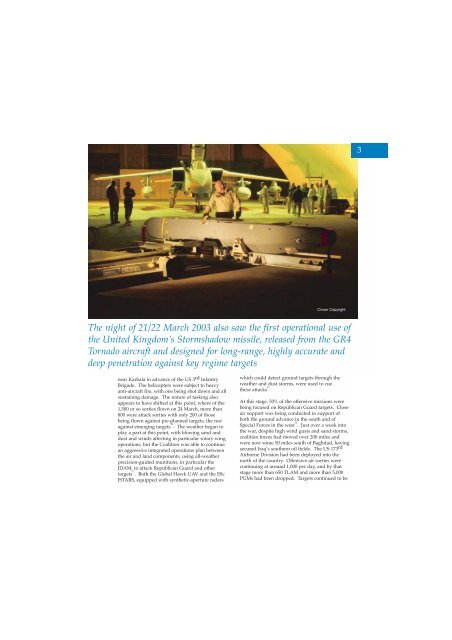Volume 6 No 4 - Royal Air Force Centre for Air Power Studies
Volume 6 No 4 - Royal Air Force Centre for Air Power Studies
Volume 6 No 4 - Royal Air Force Centre for Air Power Studies
Create successful ePaper yourself
Turn your PDF publications into a flip-book with our unique Google optimized e-Paper software.
3<br />
Crown Copyright<br />
The night of 21/22 March 2003 also saw the first operational use of<br />
the United Kingdom’s Stormshadow missile, released from the GR4<br />
Tornado aircraft and designed <strong>for</strong> long-range, highly accurate and<br />
deep penetration against key regime targets<br />
near Karbala in advance of the US 3 rd Infantry<br />
Brigade. The helicopters were subject to heavy<br />
anti-aircraft fire, with one being shot down and all<br />
sustaining damage. The nature of tasking also<br />
appears to have shifted at this point, where of the<br />
1,500 or so sorties flown on 24 March, more than<br />
800 were attack sorties with only 200 of those<br />
being flown against pre-planned targets, the rest<br />
against emerging targets 10 . The weather began to<br />
play a part at this point, with blowing sand and<br />
dust and winds affecting in particular rotary wing<br />
operations, but the Coalition was able to continue<br />
an aggressive integrated operations plan between<br />
the air and land components, using all-weather<br />
precision-guided munitions, in particular the<br />
JDAM, to attack Republican Guard and other<br />
targets 11 . Both the Global Hawk UAV and the E8c<br />
JSTARS, equipped with synthetic-aperture radars<br />
which could detect ground targets through the<br />
weather and dust storms, were used to cue<br />
these attacks 12 .<br />
At this stage, 50% of the offensive missions were<br />
being focused on Republican Guard targets. Close<br />
air support was being conducted in support of<br />
both the ground advance in the south and of<br />
Special <strong>Force</strong>s in the west 13 . Just over a week into<br />
the war, despite high wind gusts and sand storms,<br />
coalition <strong>for</strong>ces had moved over 200 miles and<br />
were now some 50 miles south of Baghdad, having<br />
secured Iraq’s southern oil fields. The US 173 rd<br />
<strong>Air</strong>borne Division had been deployed into the<br />
north of the country. Offensive air sorties were<br />
continuing at around 1,000 per day, and by that<br />
stage more than 650 TLAM and more than 5,000<br />
PGMs had been dropped. Targets continued to be
















